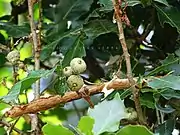Quercus floribunda
Quercus floribunda, called the Moru oak or Mohru oak, Tilonj oak and green oak, is a species of oak native to Afghanistan, Pakistan, India's western Himalaya, and Nepal,[2] typically found from 2,000 to 3,000 m above sea level. It is in the subgenus Cerris, section Ilex. An evergreen tree with a dense crown reaching 30 m, it is an important fuelwood and fodder species.[3]
 young leaves are red
young leaves are red variety in leaf shape
variety in leaf shape acorns
acorns pollarded for charcoal or fodder production
pollarded for charcoal or fodder production
| Quercus floribunda | |
|---|---|
 | |
| Quercus floribunda growth form | |
| Scientific classification | |
| Kingdom: | Plantae |
| Clade: | Tracheophytes |
| Clade: | Angiosperms |
| Clade: | Eudicots |
| Clade: | Rosids |
| Order: | Fagales |
| Family: | Fagaceae |
| Genus: | Quercus |
| Species: | Q. floribunda |
| Binomial name | |
| Quercus floribunda | |
| Synonyms[2] | |
| |
References
- Chênes, Atlas 2: 131 (1935)
- "Quercus floribunda Lindl. ex A.Camus". Plants of the World Online. Board of Trustees of the Royal Botanic Gardens, Kew. 2017. Retrieved 15 October 2020.
- Okia, Dr. Clement A. (25 April 2012). Global Perspectives on Sustainable Forest Management. ISBN 9789535105695.
This article is issued from Wikipedia. The text is licensed under Creative Commons - Attribution - Sharealike. Additional terms may apply for the media files.